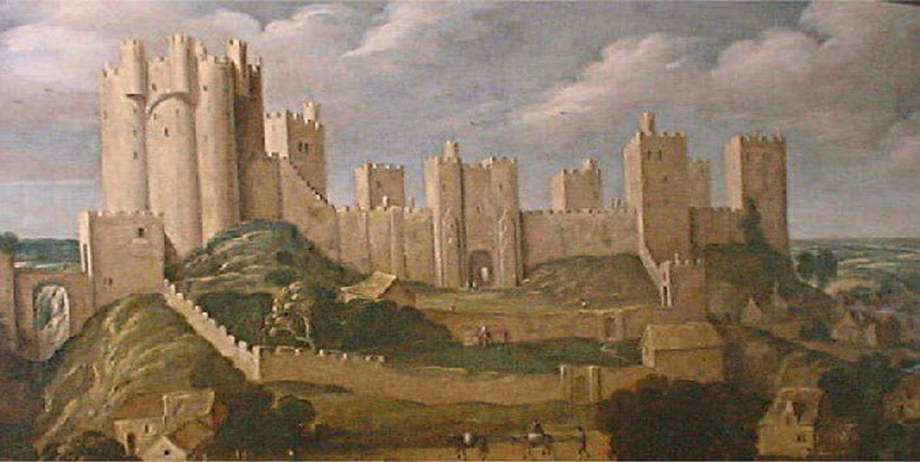
Northern Horse Renowned
for their relief of Pontefract Castle, deep in enemy territory, the Northern horse
had a fearsome reputation well before that. Under Lord Goring and especially
Sir Marmaduke Langdale, these loyal troopers had a long experience of success
in battle, and though beaten at Marston Moor, they proved more successful than
Prince Rupert’s southern regiments.
Sir Marmaduke
Langdale (1598-1661) was a Catholic Yorkshireman recognized by both sides
in the Civil War as an outstanding cavalry commander. He served under George
Goring until 1644. After the battle of Marston Moor he commanded the Northern
Horse. After his capture by the Parliamentarians in 1648 he escaped from
captivity in Nottingham Castle disguised as one of his captors, and then,
dressed as a milkmaid, reached the Humber, which he swam; he then assumed the
guise of a clergyman to make his way to London before going abroad.
The siege of
Pontefract brought about one of the most remarkable exploits of the whole
war, Langdale’s Relief March. The Northern Horse, with permission to return to
their home ground being granted by the king, left the Oxford area in late
February 1645. Across England, parliamentarian commanders were puzzled and
perplexed by the brigades purpose and its speed. Leaving Banbury on 23rd
February, Langdale routed enemy cavalry at Daventry, and on the 25th broke a
superior enemy force at Melton Mowbray. On the 26th, reinforced from Newark,
the Northern Horse pushed on, and on the 1st March came in sight of Pontefract.
Langdale charged, scattered the enemy, and took hundreds of prisoners.
The Royalist campaign started with a vigorous effort to
restore control of the Marches, with Lord Astley, Charles Gerard from South
Wales, Sir Marmaduke Langdale with his Northern Horse and princes Rupert and
Maurice in the field with some 8,000 men. The position of Chester was secured
for the time being, and the Royalists turned south to deal with the Clubmen.
Other forays were undertaken. Lord Goring swept through Hampshire to little
purpose and then withdrew to Salisbury at the end of January. In late February
and early March Langdale led an expedition of horse to the relief of
Pontefract, which he achieved for a brief space, in which it was resupplied. He
was back in Newark on 4 March. It had been a remarkable exercise, but was a
part of a series of disconnected actions without strategic coherence.
Early in 1645 Langdale’s northern horse were anxious to
return north to be nearer their threatened homes and relieve their friends
under siege at Pontefract Castle in Yorkshire. Langdale wrote to Rupert on the
12th January on this subject.
“ I beseech your
highness let not our countrymen upbraid us with ungratefullness in deserting
them, but rather give us leave to try what we can do; it will be some
satisfaction to use that we die amongst them in revenge for their quarrels.”
Langdale was given permission to try and headed north with
around 2000 horse defeating Colonel Rossiter at Melton Mowbray on the 25th
February. Langdale was joined by 800
infantry from Newark and continued north. On the 1st March Parliamentarian
forces tried to halt Langdale at Wentworth but were defeated and fled back to
Pontefract. Langdale advanced to Pontefract and engaged the besieging forces
under General Lambert. Supported by the forces from Pontefract Castle Langdale
defeated Lambert at Chequerfield and relieved the Castle. The whole daring raid
had been a considerable feat of arms by Langdale and clear testimony as to his
leadership, skill and the fighting qualities of his men. It was arguably the
most brilliant piece of soldiering of the entire war. The stores and munitions
captured enabled the Pontefract garrison to resupply and continue to hold out
when the siege resumed a month later. The Royalist reputation amongst the
civilian population of the area was however tarnished by the conduct of
Langdale’s troopers who left a trail of rape and pillage in their wake.
Langdale discovered on arriving at the castle that is
brother in law Abraham Sunderland died during the siege. Amongst others who
died in the siege was Col James Washington, son and heir of Darcye Washington
of Adwick in Yorkshire. James was an ancestor of the first US President George
Washington. Darcye Washington, brother of James, died at the siege of Newark
and Sir Henry Washington was another prominent Royalist who distinguished
himself at Bristol and Worcester
Langdale then proceeded south west to Bridgnorth and joined
forces with Prince Maurice and Sir Jacob Astley.